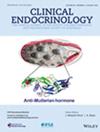Treatment of Subclinical Hyperthyroidism and Incident Atrial Fibrillation
Abstract
Context
Treating overt hyperthyroidism prevents atrial fibrillation (AF). Though subclinical hyperthyroidism (SH) has been associated with AF, it is unknown whether treating SH prevents AF.
Objective
We aimed to identify the association between treating SH and incident AF.
Design
In a pharmacoepidemiologic retrospective cohort study, patients diagnosed with SH between 2000 and 2021 were followed.
Patients
Outpatients ≥ 18 years with biochemical SH and without prior AF, hypothyroidism, thyroid cancer, pituitary disease, or pregnancy were included.
Main Outcomes
The primary outcome was incident AF. Secondary outcomes were ECG and echocardiographic features associated with AF.
Results
Of 2169 patients screened, 360 (131 treated and 229 untreated) were followed up for a mean of 4.27 years. In the treated and untreated groups, AF occurred in 4 (3.1%) and 15 (6.6%) patients (p = 0.15), and AF incidence was 0.8% and 1.4%/year (p = 0.31), respectively. The hazard ratio (HR) for treatment as a time-dependent variable was 0.60 (95% CI 0.19–1.92; p = 0.39). As some cases of AF were documented nearly simultaneously with SH treatment, a sensitivity analysis was performed reassigning two patients diagnosed with AF < 30 days after starting SH treatment to the untreated group. Here, in the treated and untreated groups, AF occurred in 1.6% and 7.4% (p = 0.02), and AF incidence was 0.4% and 1.8%/year (p = 0.02), respectively. The HR was 0.25 (0.06–1.13; p = 0.07). There were no differences in ECG or echocardiographic features.
Conclusion
There was an overall trend towards lower incidence and prevalence of AF following treatment of SH, supporting the need for larger scale studies.


 求助内容:
求助内容: 应助结果提醒方式:
应助结果提醒方式:


